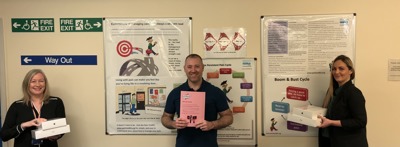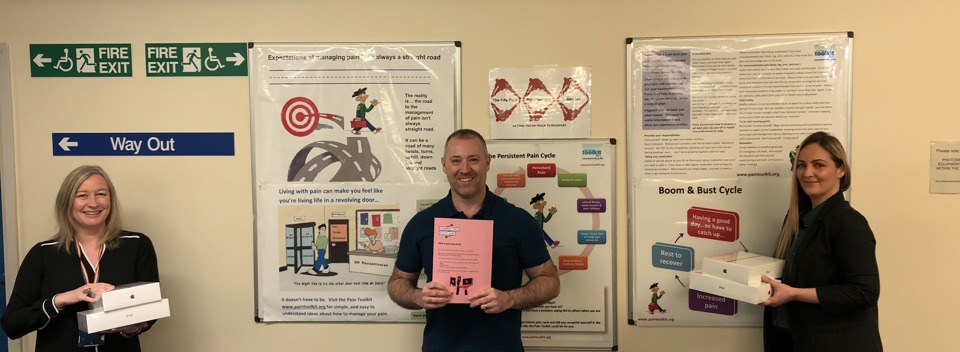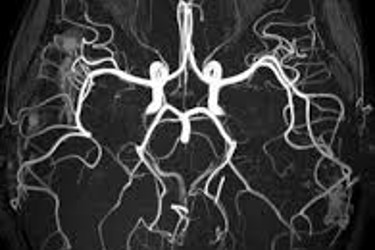



Getting online is something that most people simply take for granted. Who hasn’t woken up early with a question in their mind and quickly turned to google to get the answer? If you want to check the bus time do you call the bus operator? No, most likely you will check their website. Need to check if an essential retailer is open? Try their Facebook page.
Whether we like it or not, these days, the internet is our lifeline. Not only does it provide information to keep us informed and entertained, we now rely increasingly upon digital connectivity just to keep in touch.


Dr Trudi Dickson, Clinical Psychologist is to the left, Mrs Lynn Cochrane, Administrator, right, with Dr Paul Cameron Head of NHS Fife Pain Service, centre.
Throughout the coronavirus crisis and, during the long periods of lockdown or when we’ve been advised to stay-at-home for the safety of ourselves and others, the internet has become our social life too. We’ve had to come up with new ways of connecting via platforms such as Skype, Zoom, Teams or Facetime; care home residents with family, patients in hospital with relatives and home workers with their workplace – we’ve all done so with the assistance of digital technologies.
So, take a moment to imagine not having the ability to get online. Perhaps you don’t have a laptop, or a smart phone, an iPad or pc. A broadband router – what is that? It could be that you are on a tight budget and need to make tough choices, potentially between buying food and getting online. Faced with such tough choices most people would choose the former - we hope! Thus sadly, the need to make such choices leads to the situation that many local families here in Fife find themselves in, that of being digitally disenfranchised.
It was exactly this situation that Professor Paul Cameron wished to address when he and colleague Dr Trudi Dickson decided to apply to Connecting Scotland for a funding package which could see a number of local families, who they knew to be experiencing digital poverty, supported to get online.
Professor Paul Cameron is the head of the NHS Fife Pain Service. The service covers the whole of Fife and which supports both inpatient and outpatient care over a number of locations, working from departments in Queen Margaret and Whyteman’s Brae Hospitals. Through their work in the Pain Management Service, Paul and colleagues had identified several patients who they felt would benefit from better access to the internet and from the wealth of health advice and resources found there.
Individuals identified were not only clients of the Pain service, but also some long- term paediatric patients who have a need to access websites, Near me services and wider public services and information sites such as NHS 24 or NHS Inform. The Pain team, Professor Cameron points out, finds that putting health resources online can be a very effective way of keeping in touch with patients, especially long-term patients. They are making increasing use of the NHS Fife website and Twitter pages as a way off effectively signposting to health information. But this only works of course, if patients have reliable access to online platforms, which isn’t universally the case, a situation which is underlined further during the current pandemic with the temporary closure of libraries and community centres.
Connecting Scotland is an organisation which has been set up to specifically support the most vulnerable in Scotland to get online. Having submitted an application to them Paul, along with Clinical Psychologist colleague Dr Trudi Dickson and ably assisted by service administrator Lynne Cochrane. Thus the three were delighted to recently learn that their bid to Connect Scotland had been successful and that the Pain service was to be given 15 iPads and dongles.
The bid criteria had simply been to provide connectivity to those that need it most; families with poor or no internet access, with children under 18 who’d benefit from being online. Using these criteria, and on a first come first served basis thereafter, Paul and colleagues have now identified the 15 families
who will receive their new iPads. Paul explained that this is a real boost to parents who’re delighted to be able to offer this lifeline to their children to help them to get online. The iPads will allow them to access not only paediatric Near me appointments during the current pandemic, but a whole host of other services and websites, information and importantly education, whilst schools remain closed to certain age groups. ‘There have been a few tears’ explained Paul ‘when we called our patients to tell them the news. They could not have been happier or more grateful for this practical help’. The Pain team are currently working on getting the devices out to clients as quickly as possible with 3 already delivered and appointments being made to drop off the remaining devices.
The families could not have been happier or more grateful for this practical help.
It was particularly important to the Pain service that there were no strings attached to receiving the devices. The iPad are gifts and will not need to be returned or paid for in any way. The technology to access the internet is by use of a mobile SIM. Connect Scotland recommends a service known as Mi-Fi, short for mobile Wi-Fi. By using a SIM instead of a phone line or cable, this removes the requirement to wait for a broadband installation engineer – perfect for getting online quickly with minimum fuss. Mi-fi is a wireless device that creates a local wi-fi signal to be able to access the internet, similar to home broadband router.
The costs from the provider associated with the SIM card will be met by Connect Scotland over the life of the SIM card. The Pain Service is realistic in the knowledge that they cannot solve digital connectivity issues for everyone in Fife. However they are delighted to have been able to connect local families who’ve perhaps lost jobs, or those on low incomes struggling to manage financially to benefit from digital connectivity, and the access to information that this brings, which most of us nowadays simply take as a given.
